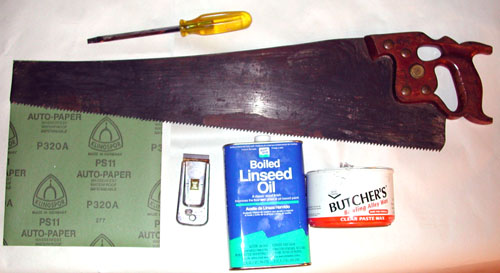Removing rust from a saw blade is simple. Start with basic household items.
Restore your saw’s shine with these easy steps. Rust can ruin tools quickly. Your saw blade deserves better care. Rust not only looks bad but can also affect performance. A clean blade cuts more smoothly, saving time and effort. Fortunately, you don’t need special products to clean rust.
Items like vinegar and baking soda can work wonders. Regular maintenance ensures your tools last longer. This guide will help you remove rust effectively. You’ll learn how to clean and protect your saw blade. Keep your tools in top shape with these simple tips. Let’s get started on restoring your saw blade’s shine.

Credit: www.vintagesaws.com
Rust Removal Basics
Removing rust from a saw blade involves basic steps. Begin by scrubbing the blade with steel wool or sandpaper. Apply vinegar or baking soda for stubborn spots, letting it soak before scrubbing again. Finish with a wipe of machine oil to protect the blade from future rust.
Rust on a saw blade can be more than just an eyesore; it can affect the performance and lifespan of your tool. Luckily, removing rust doesn’t have to be a daunting task. With a little bit of knowledge and the right approach, you can restore your saw blade to its former glory. Let’s dive into some rust removal basics to help you get started.Identifying Rust Spots
Before you start, it’s important to know what you’re dealing with. Rust spots can vary in size and severity. You might notice small, orange specks or larger, flaky patches. Take a close look at your saw blade. Check both sides and especially around the teeth, as these areas are prone to rust. Remember, a thorough inspection helps you plan your next steps effectively.Gathering Necessary Tools
Once you’ve identified the rust, gather the tools you’ll need. Common household items can do wonders for rust removal. Consider using materials like white vinegar, baking soda, or lemon juice. A wire brush or some sandpaper can also be handy for tougher spots. You might be surprised at how everyday items can save your saw blade. Did you know that aluminum foil can scrub off light rust effectively? It’s an unexpected yet simple solution. Think about what you have at home before heading to the store. This can save you time and money while still getting the job done right. Have you ever used a household item to solve a tricky problem? It’s satisfying to find solutions in places you least expect.Using Vinegar Solution
Have you ever picked up a saw blade, only to find it tarnished with rust? It’s not just an eyesore; rust can compromise the efficiency and safety of your tools. One simple and effective way to tackle rust is using a vinegar solution. Vinegar is not just for salad dressings; it can be your ally in rust removal. It’s natural, readily available, and budget-friendly. Let’s dive into how you can rejuvenate your saw blade with this household hero.
Soaking The Blade
Start by filling a container with enough white vinegar to fully submerge your saw blade. You might be surprised by how vinegar can work wonders. Place the blade into the vinegar bath and let it soak. Allowing it to rest in the solution for several hours, or even overnight, can yield impressive results.
Consider this: the longer the soak, the easier the rust removal. But why vinegar? It contains acetic acid, which reacts with rust and loosens its grip on metal surfaces. You’ll notice the rust breaking down into flakes. It’s fascinating how something so simple can be so effective.
Scrubbing Away Rust
After the soak, it’s time for a little elbow grease. Remove the blade from the vinegar and use a brush or scrubbing pad to tackle the rust. You’ll find that scrubbing is much easier after the vinegar has done its magic. The rust will flake off, revealing the shiny metal beneath.
Isn’t it satisfying to see the transformation? You might even find yourself enjoying the process. Just make sure to use gloves to protect your hands and avoid scratching the blade. Once the rust is gone, rinse the blade thoroughly with water to wash away any vinegar residue.
Now, take a moment to think: what other rusty tools could benefit from a vinegar bath? You’ve got the knowledge, so why not apply it elsewhere? Rust removal doesn’t have to be a chore, and with vinegar, it’s almost too easy.
Baking Soda Technique
Rust can affect your saw blade’s performance. The Baking Soda Technique offers a simple solution. Baking soda, known for its gentle abrasive properties, can effectively remove rust. This method is easy to follow, requiring minimal materials. It’s a practical approach for those wanting to restore their tools.
Creating A Paste
Start by mixing baking soda with water. Aim for a thick paste. Ensure the mixture isn’t too runny. A thicker paste adheres better to the blade. Use a small bowl to combine the ingredients. Stir until smooth. Consistency is key for effective rust removal.
Applying And Cleaning
Spread the paste over the rusted areas. Use a cloth or brush for even coverage. Let it sit for about 30 minutes. The paste works by breaking down the rust. After waiting, scrub the blade gently. Use a soft brush for this step. Once the rust loosens, rinse with water. Dry the blade thoroughly to prevent new rust.

Credit: www.reddit.com
Lemon And Salt Method
Remove rust from a saw blade using lemon and salt. First, sprinkle salt on the rusted areas. Then, rub with a lemon half. The acid in the lemon and abrasiveness of the salt work together to lift the rust away.
Rinse and dry the blade thoroughly afterward.
Rust on your saw blade can be more than just an eyesore; it can affect the tool’s performance and lifespan. One of the most effective and natural ways to tackle this issue is the Lemon and Salt Method. This simple yet efficient technique uses the natural acidity of lemon and the abrasive quality of salt to clean rust off your saw blade. Let’s dive into the details of how you can use this method to restore your blade’s shine.Preparing The Mixture
Begin by gathering a fresh lemon, some coarse salt, and a small bowl. Squeeze the juice of the lemon into the bowl, ensuring you remove any seeds that might have slipped through. Add about two tablespoons of salt to the lemon juice and stir until it forms a gritty paste. You might wonder why lemon and salt? The lemon’s acidity works to dissolve rust, while the salt provides the scrubbing power needed to remove it. This combination is not only effective but also easy to clean up afterward.Buffing The Blade
Once your mixture is ready, apply it generously to the rusty spots on your saw blade. Use a soft cloth or sponge to rub the paste onto the blade in circular motions. This helps the salt to gently scrape away the rust while the lemon juice penetrates and loosens it. Have you ever noticed how satisfying it is to see the rust fade away as you scrub? Keep buffing the blade until you see the clean metal surface emerge. After buffing, rinse the blade thoroughly with water to remove any lemon and salt residue. Dry it completely with a clean cloth to prevent new rust from forming. Doesn’t it feel rewarding to see your once-rusty saw blade looking almost new again? This method not only saves you money but also keeps harmful chemicals out of your toolbox. Give it a try and see the difference it makes in your DIY projects.Commercial Rust Removers
Commercial rust removers offer a reliable solution for cleaning saw blades. These products are designed to dissolve rust quickly and effectively. They save time and effort compared to manual methods. With a variety of options available, finding the right one is crucial. Let’s explore how to choose and use these products effectively.
Choosing The Right Product
Selecting the right rust remover is essential for optimal results. First, consider the severity of the rust on your saw blade. Some products work better for light rust, while others are suited for heavy corrosion. Read labels carefully to understand each product’s strengths.
Check if the product is safe for metal surfaces. Some rust removers can damage the blade if not compatible. It’s also wise to consider environmental impact. Eco-friendly options are available for those concerned about chemical exposure. Customer reviews can offer valuable insights into a product’s effectiveness and ease of use.
Following Instructions
Always follow the manufacturer’s instructions when using rust removers. This ensures safety and effectiveness. Wear protective gear like gloves and goggles to prevent skin and eye irritation. Apply the rust remover as directed, ensuring even coverage on the blade’s surface.
Allow the product to sit for the recommended duration. This gives the chemical enough time to dissolve the rust. After treatment, rinse the blade thoroughly with water. Remove any residue to prevent future corrosion. Finally, dry the blade completely to avoid new rust formation.
Preventing Future Rust
Removing rust from a saw blade can extend its life and improve performance. Gently scrub the blade with steel wool and vinegar to lift rust. Dry thoroughly and apply a thin oil layer to prevent future rust.
Preventing rust on your saw blade not only extends its life but also keeps your cutting tasks smooth and efficient. By adopting some simple habits, you can ensure your tools remain in top condition. Let’s explore how you can keep rust at bay with some straightforward maintenance and storage tips.Regular Maintenance
Regular maintenance is your first line of defense against rust. Clean your saw blade after each use. A quick wipe with a dry cloth removes moisture and debris that can cause corrosion. Consider using a light coat of oil on the blade. This oil acts as a protective barrier against moisture. A few drops on a cloth are enough to cover the blade effectively. Inspect your saw blade periodically for any signs of rust. Address minor rust spots immediately with a rust remover. This proactive approach prevents them from spreading and causing more damage.Proper Storage Tips
Proper storage of your saw blade is crucial in preventing rust. Store your saw in a dry area, away from moisture and humidity. Moisture is a common culprit behind rust formation. Use a protective case or a blade guard for your saw. These accessories shield your blade from environmental factors. They also prevent accidental nicks and scratches that can lead to rust. Avoid storing your saw directly on concrete floors. Concrete can retain moisture, increasing the risk of rust. Instead, consider hanging your tools or using a dedicated tool rack. By implementing these simple strategies, you protect your saw blade and ensure it performs efficiently. What other tools in your workshop could benefit from similar care?Safety Precautions
Before removing rust from a saw blade, prioritize safety. Handling chemicals and tools can pose risks. Proper precautions ensure a safe and effective cleaning process.
Wearing Protective Gear
Always wear protective gear when cleaning a saw blade. Safety goggles shield your eyes from flying debris. Gloves protect your hands from harsh chemicals. A dust mask prevents inhaling fine particles. Ensure your gear fits well for maximum protection.
Ensuring Adequate Ventilation
Work in a well-ventilated area. Open windows or doors to allow fresh air. Chemical fumes can be harmful when inhaled. A fan can help circulate air, reducing fume concentration. Avoid confined spaces where air cannot move freely.

Credit: www.reddit.com
When To Seek Professional Help
Consider professional help when rust persists despite scrubbing. Rust can damage the blade’s efficiency and lifespan. Expert cleaning ensures the saw blade remains sharp and safe for use.
When you’re dealing with a rusty saw blade, home remedies can often do the trick. However, there are times when the rust damage is severe, and professional help becomes necessary. Knowing when to make that call can save your blade from permanent damage and ensure your safety.Recognizing Severe Rust Damage
You might be wondering, how can you tell if rust damage is severe? Look for deep pitting or extensive corrosion that has altered the blade’s surface significantly. If the blade looks warped or feels rough to the touch, it might be beyond DIY repair. A personal story might resonate here. I once tried to fix a saw blade that seemed salvageable, but the rust had eaten into the metal. It ended up snapping during use, nearly causing an injury. That taught me the importance of recognizing when a blade needs professional attention. Can you afford to ignore these signs? If you’re unsure about the condition of your blade, don’t risk it. Seek expert advice to avoid compromising your safety or further damaging the tool.Finding Expert Services
Where do you find professionals who can restore your saw blade? Start by checking local hardware stores. Many offer repair services or can recommend someone trustworthy. Online searches can also help. Look for reviews and ratings to find reputable services in your area. Platforms like Angie’s List or Yelp might offer insights into the best places nearby. Have you considered reaching out to woodworking communities? Forums and social media groups often have members who can recommend skilled professionals. You might even connect with someone who has faced similar rust issues and can offer guidance. Engaging with professionals not only saves your blade but might also teach you preventive measures to avoid future rust problems. Is your blade telling you it’s time for expert care? Listen closely, and don’t hesitate to reach out for help.Frequently Asked Questions
How Do You Remove Rust From Saw Blades?
Use a wire brush to scrub the saw blade. Apply white vinegar to dissolve rust. Rinse and dry thoroughly. Use baking soda paste for stubborn rust spots. Finish with a light coat of oil to prevent future rusting. Ensure safe handling throughout the process.
Will Wd40 Remove Rust From Tools?
Yes, WD-40 can help remove rust from tools. Spray it on the rusty areas and let it sit briefly. Use a scrub or brush to clean the rusted surface. Wipe the tool with a clean cloth. Regular application can also prevent future rust formation.
Will Vinegar Clean Saw Blades?
Yes, vinegar effectively cleans saw blades. Soak the blade in vinegar for 30 minutes to remove rust and residue. Rinse thoroughly and dry to prevent corrosion. Vinegar is a natural, eco-friendly cleaning solution for maintaining saw blades in good condition.
Can You Use Wd40 To Clean A Saw Blade?
Yes, you can use WD-40 to clean a saw blade. It effectively removes rust and grime. Spray it on the blade, then wipe with a clean cloth. Ensure the blade is dry before using. WD-40 helps maintain the blade’s performance and longevity.
Conclusion
Removing rust from a saw blade isn’t hard. Start with simple cleaning steps. Use vinegar or baking soda for stubborn spots. Sandpaper helps with rough areas. Regular maintenance prevents rust from returning. Keep blades dry and clean. Store them in a cool place.
Protect them with oil or wax. A clean blade cuts better and lasts longer. These steps make your tools reliable. Rust-free tools save time and effort. Your saw blade will thank you. Enjoy smooth cutting with clean blades. A little care makes a big difference.
Happy cutting!


